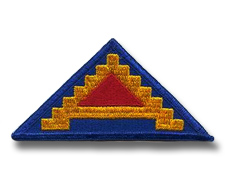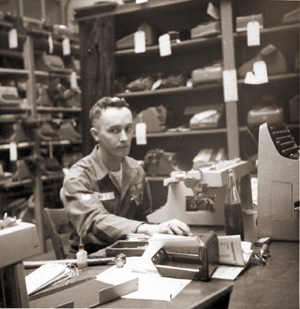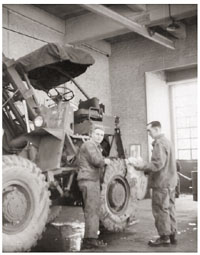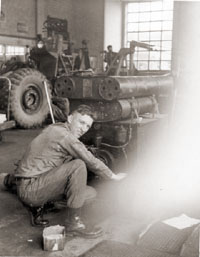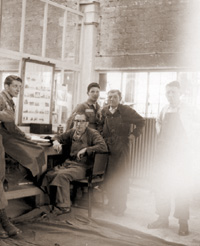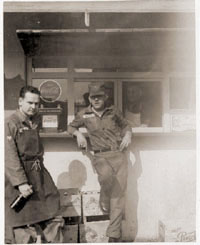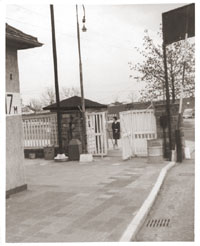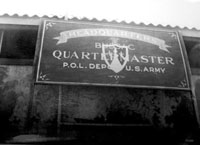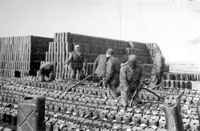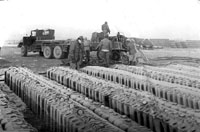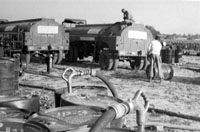| If you do
NOT see the Table of Contents frame to the left of this page, then
Click here to open 'USArmyGermany' frameset |
|||||||||||||
|
15th
Quartermaster Battalion |
|||||||||||||
|
|
|||||||||||||
|
|||||||||||||
|
|
|||||||||||||
| 15th QM Battalion History | |||||||||||||
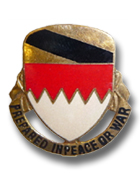 15th Quartermaster Battalion DI 15th Quartermaster Battalion DI |
|||||||||||||
| 1951 | |||||||||||||
The 15th QM Battalion arrived at Bremerhaven from the United States on 21 October 1951 and was attached to the 2nd QM Group at Munich, Germany . On 1 October 1958, the 14th and 15th QM Battalions were detached from the 2nd Quartermaster Group and attached to the Hanau Provisional Group, which was redesignated as the 6th QM Group on 1 December 1958. |
|||||||||||||
| If you have more information on the history or organization of the 15th QM Bn, please contact me. | |||||||||||||
| 1963 | |||||||||||||
| (Source: Email from John R. Sitten, Jr.) | |||||||||||||
[INITIAL DRAFT HISTORY – 26 MAR 96] 15TH QUARTERMASTER BATTALION (GS) – 1963-1965 |
|||||||||||||
| (Source: Email from James DeClerck, 377th Trans Co & 40th Trans Co, 1963-64) | |||||||||||||
| I was initially assigned to the 377th Transportation Company and arrived at Rhein Main Air Base on Jan. 1, 1963. After a jeep ride from to Mannheim I settled into the BOQ at Coleman Barracks. A few weeks after arriving, qualifying for a military drivers license in 1/4, 3/4, 2.5, 5, and 10 ton trucks and escorting a few convoys of heavy trucks carrying tanks and other "tracks" to or from training areas, I was transferred to the 40th Transportation Company at Turley, not Taylor, Barracks. The Commander was 1LT John Clifford, later replaced by 1LT John Henry Stanford, not Sanford. Airborne Ranger Stanford's basic branch was Infantry and he had previously been a Davy Crocket Platoon Leader in a unit in Germany. Some of the other officers in the 40th at the time were CWO Singleton, not Singletary, and platoon leader LTs Logan, Bennett, Gallagher and myself. I served as Commander of Company C, 15th QM Bn during a few months before my rotation back to CONUS in October 1964. I remained in the USAR, transferred to the Civil Affairs Branch, served in several CA units and USAR Schools as I was transferred around the U. S. by Kodak, my civilian employer. I served as a MOBDES officer before retiring as an LTC in 1990. Some other names that come to mind: LT Lyn Carraway, Commander of the 342nd Trans Co. at Turley Barracks. LTs Tim Rhein, Mike Corpus and Jim Kirby, platoon leaders of the 377th Trans. Co. When I arrived at the 40th TC in early 1963 the 1st Sgt's name was Patterson. Later, 1st Sgt Patterson transferred and was replaced by 1st Sgt Karhan. Both were outstanding soldiers. During one of my active duty tours at the Military Traffic Management Command shortly before my retirement, MG Stanford, MTMC Commander, contacted Mrs. Karhan and arranged to meet her at the grave of her late husband. MG Stanford, LTC John Logan (Ret) and I, along with Mrs. Karhan, visited his grave at Arlington National Cemetary and paid respects to our colleague from the 40th TC. |
|||||||||||||
|
|
|||||||||||||
| B Company / 511th Quartermaster Company | |||||||||||||
| 1960 | |||||||||||||
| (Source: Email from Larry Harris, 511th QM Co and B Co, 15th QM Bn) | |||||||||||||
Here is a funny story for you:
One of my call's was to a WAC unit stationed in Heidelberg. The unit was run by a red headed Major. I had been called to this unit many times before. So I was almost on a first name basis with the Major. She had a girl who complained that her typewriter was always skipping. So I told her to go ahead and type for me and I would watch. I saw what the problem was and when into the Major's office. I told the Major to get the girl checked out for glasses. It seem that she could not see well enought and would lean forward. The problem was the girl was very well endowed. Her bust would hit the space bar. That really cracked the Major up. She thanked me and said she would look into getting that girl's eyes checked. I never had a call for that typewriter again. |
|||||||||||||
| C Company / 16th Service Company | |||||||||||||
On 14 September 1961, Company C, 15th Quartermaster Battalion was redesignated as the 16th Quartermaster Company. The company was then activated on 25 September 1961 in Germany. On 11 August 1965, the 16th QM Co was reorganized and redesignated as the 16th Service Company. |
|||||||||||||
| 562nd Quartermaster Company (Petroleum Supply) | |||||||||||||
| 1953 | |||||||||||||
| (Source: Email from Bob Glenn, 562nd QM Co) | |||||||||||||
| I was stationed
with the 562nd QM Co (Petrl Sup, Mbl)
from August 1953 to February 1954 in Leopold Kaserne, Munich. Stationed
with me in Leopold kaserne was the 626th Refrigeration Company (QM
Co (Refrig, Mbl)). They also had a detachment in Nurnberg. I remember that Leopold Kaserne was located near the corner of Dachau Strasse and Leopold Strasse. Directly across the street was the Quartermaster Depot. It was guarded by Polish Guards. I was the driver for the Depot Commanding Officer. I can't remember his name. Just around the corner across the street on Dachau Strasse was the Motor Pool where I was also for a time a dispatcher. The trucks for the 562nd Petrl. Co. were there as well as the 626th Refrigeration Co. In February 1954, the 562nd was sent to Camp Bussac, France were it was deactivated. I was transferred to Ingrandes Depot near Ingrandes, France. I tried to get a copy of my 201 file, but those records went up in smoke during a fire. All I could get was a statement that I had served in the US Army from February 1953 to February 1958 and I was Honorably Discharged. So I have been working the Internet trying to find out information. It is like my unit never existed. I was very young at the time and unfortunately didn't save copies of orders and such. I left Ingrandes Depot in April 1954 and was assigned to the (102nd Inf Regt) of the 43rd Inf Div in Augsburg at Sheridan Kaserne. That unit became the 11th Inf Regt of the 5th Inf Div. While in Service Company I attended NCO school and was Motor Sgt. then was transferred to Supply and Ration Breakdown. Iin 1956 I was shipped back to Fort Ord where I began my service. After returning to Fort Ord I continued my duties and Ration Breakdown Sgt. for my Brigade. I was discharged as SP5. I have been back to Munich many times and traveled by the Leopold kaserne. The last time German troops were using the Kaserne. Across the street where the Quartermaster Depot used to be is now the Olympic Stadium. Of course the motor pool where I worked (which at the time was a bombed out shell) is long gone. Thanks for any help you can give. Maybe someone will remember the outfit. |
|||||||||||||
| (Source: Email from Tom Sweeney, 562nd QM Co, Camp Bussac) | |||||||||||||
| I served in the 526nd QM at Camp Bussac, France in 1954. I see on your web site that a Bob Glenn wanted some information on this outfit. I know that the 562nd was stationed in Germany before moving, (near Munich) or should I say München? I have many photos of the POL Depot at Camp Bussac. Thank you for any help that you can give. |
|||||||||||||
|
|||||||||||||
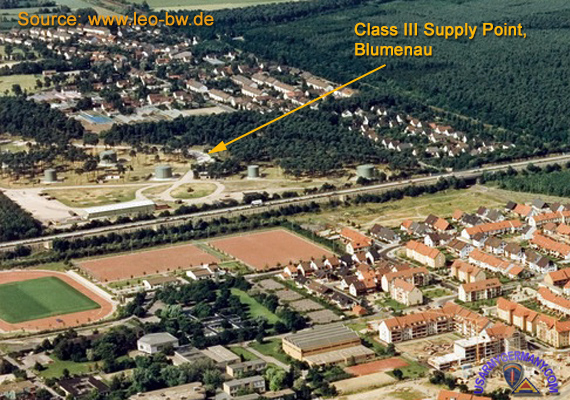 The Class III Supply Point at Blumenau (near Colemans Barracks, Sandhofen) |
|||||||||||||
| 1962 | |||||||||||||
| (Source: Email from Thomas Cassin) | |||||||||||||
| I arrived at Rhein Main the first of October, 1962 at the start of the Cuban Missle Crisis. My orders read 15th Qm Bn, Kaefertal, Germany.
All my buddies from the flight were met by someone from their unit, but I had none. After much questioning, I took a train to Mannheim. There was no greeting committee there either. My cab driver took me to a couple of kasernes before we found Funari Barracks. It was Sunday and the duty officer, Capt. Gaskins, at the 15th HQ had no idea what to do with me. Monday morning at Commander's conference I was assigned to the 562nd QM Det (Petroleum Products Lab, Mobile). 562nd QUARTERMASTER DETACHMENT The lab was at the Blumenau Class III site you refer to in the photo above. I never heard or remember it being called anything other than "the tank farm". The lab and my office were at the Class III facility. On one half of the property were several large oil storage tanks (large). At the far end of the property was a rectangular, gable to gable roof, office structure. Most of the building was occupied by civilian employees doing paper work. The 562nd office (approx. 15'x25') was on the far end facing a Polish Labor Service unit motor pool-parking lot. The lab was parked outside our office about 30' away. The Class III office was populated by German nationals, a few GIs and a Lt. We did not interact hardly at all. All I could figure out was the POL came in on the Rhein and flowed by pipeline to the tank batteries. The 562nd performed no services to them. The 562nd's mission was to provide quality control testing to all units in 7th Army. We had a yard full of jerry cans from stockpiles and basic loads from all over Germany. Our lab was in a big mobile trailer. The lab equipment was basic stuff that was exactly what we had in Chemistry 318 -- Quantitative Analysis at the Univ. of Texas. I remember going over to a landing on the Rhein and checking a barge before oil was unloaded. I got to observe some locals hunting hares in the adjoining field. The hunters would stand at each rabbit hole in a big circle. One guy would drop a ferret in a hole and a few moments later one of the other hunters would shoot the hare as he fled from the ferret. Then they would drop the ferret down another hole. I imagine we were taking samples from the barge before the oil was sent on to the tank farm. My Sgt, SFC Squires, was "the man" when it came to Class III. Pres. Kennedy landed in Holland before going to Berlin to make his famous speech. Officials came in the night to take Sgt. Squires to test the gas before they put it in the Presidential helicopter. SFC Squires and Spec 4 Bevil kept me straight. Squires had a Masters degree from Drake Univ. and all the lab guys were college or high school graduates. I had a strong chemistry background so it was "good duty" for me. SFC Squires retired to Ft. Lee and I had the honor of having dinner with Sgt. Squires and his frau at Ft. Lee while doing Reserve duty. Spec.4 Bevil went to OCS, survived Vietnam, went to the Hague as an interpreter and was a Major by that time. Thanks for the picture but I can't see anything familiar except the POL tank batteries. I remember Coleman Barracks being on one side of the road and the BOQ and Officer's Club on the other. While I was in the BOQ, I walked from there thru a nice little wooded area like a small forest. As I came out of the woods, the tank farm was just ahead. It was about a 30 min. trek. My guys thought I could do better and they would pick me up at the BOQ after that. One last thought about the Class III office personnel. I only had extended conversations with a few of the civilians. One was a Jewish man who didn't seem bitter at all about the WWII experience. I wish I had quizzed him more. One very interesting thing about the 562nd was the unit next door to us. There was a barbed wire fence between us and there were many vehicles parked military style across the fence. Each morning some guys in olive drab uniforns would come out, start the engines, do something, and then go back to somewhere. In the winter they would skate around on the ice. As soon as I came to this unit I was told those were Polish troops (= Labor Service) and to not interact or acknowledge they existed. There were a lot of security concerns and were constantly advised to not talk to anyone suspicious. Spies everywhere they said. "C" COMPANY, 15th QM BATTALION While I was "short" Lt. DeClerc was assigned to the unit. I see where he was the next CO after me. I served under Lt. Col. Frank McFadden whom I respected greatly. I have used his words of wisdom throughout life. Lt. Col. Cool was cool indeed! I learned a lot from him. Col. Cooper was coming in while I was leaving. The 15th. had many good officers like Maj. Bob Davis, Capts. John Sitton, Gaskins, Bagdanov, McCarthy, and others I can't recall their names. Lts. Andy Dumovic, Bland Davis , Warner , Wade McSwain , Connell are some I remember. Lt. John Stanford and I were on a very friendly basis. We had planned to get together sometime but it never happened. John had a distinguished career and retired a Maj. Gen. He then became Superintendent of schools in Seattle, Wash. I saw him on TV being asked how to solve some of the country's great problems. A few months later I decided to call him. It took some doing and I reached his secretary. It was emotional when she told me of his death to cancer. C Co. of the 15th was located at Taylor Barracks right near the autobahn. I never knew about the swastikas on the railings that John Sitton told of -- wish I had. The basement of our building was huge. It consisted of high ceilings and wide halls with various rooms here and there. I do know the tunnels were extensive and was told the Nazis would use them to move vehicles all over Mannheim so the civilians were not alarmed. I don't know about the other kasernes but I learned on night that the guards walked the perimeter with loaded weapons. I checked a guard, saw the ammo, and when he had no clue what his general orders were, I got nervous. The same night I strapped on a .45 and went to the EM Club to counted the receipts of the slot machines. I learned, quickly, that it was no place for a Lt. to be. The hostility to officers was pervasive. That was one tough post. I hope this is of some use to you. I have had much pleasure recalling (imperfectly) those days and people. We had many good memories. Oh, I forgot to say that I came home in June, 1964. When I got home I joined a family business. My son now owns the almost 100 year old company. It has been a pleasure to recall those days in the 15th. |
|||||||||||||
| 619th Supply Company | |||||||||||||
| 1965 | |||||||||||||
| (Source: STARS & STRIPES, Aug 19, 1965) | |||||||||||||
| The 619th Supply Company has been activated at Mannheim under the COSTAR concept. The unit is subordinate to the 15th QM Bn. Current CO of the company is 1st Lt Paul A. von Hoene. |
|||||||||||||
